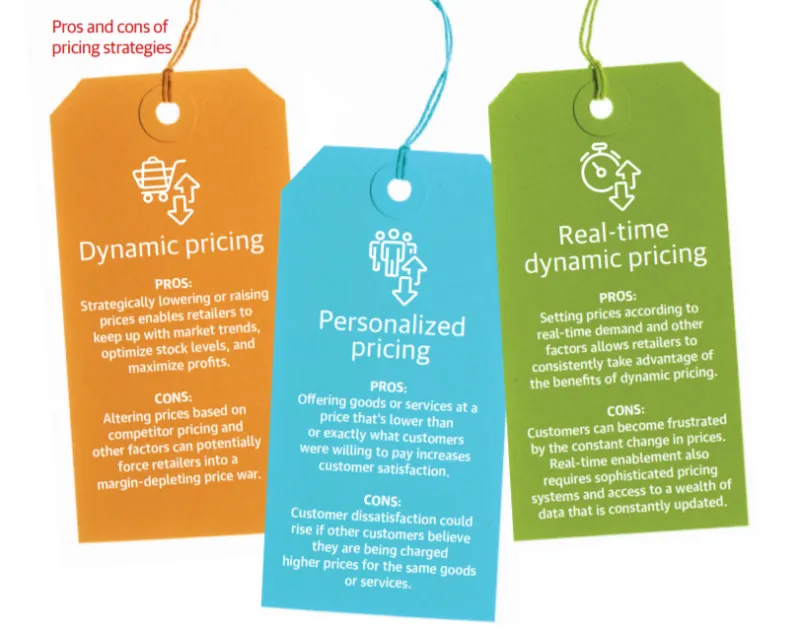Dynamic pricing—the practice of setting flexible prices for productS or services—has never been more competitive or complex. Whereas businesses in the past had limited insights into how much customers would be willing to pay, today they have a multitude of tools and data sources to help them accurately price their merchandise on the fly.
Technology has made it possible for companies to set prices on a personalized and/or real-time basis. Yet, the most successful companies are not necessarily the ones that use the most sophisticated pricing models. We’ll explore the human component of dynamic pricing and explain why customer expectations and experience should play a role in the rate at which brands embrace innovative pricing techniques.
Dynamic pricing, with a twist
Dynamic pricing is not new. Airlines have used dynamic pricing strategies for decades to fill as many seats as possible for the highest price that passengers are willing to pay. Retailers use dynamic pricing to offload aging or excess inventory, and many hotel owners work with third-party providers who use dynamic pricing to sell empty rooms.
“In some instances, consumers may not even be aware when dynamic pricing occurs,” says Saibal Ray, a professor of operations management at McGill University. “Even happy hour is a form of dynamic pricing.” As companies become more adept at using data to drive pricing decisions, more industries have implemented dynamic pricing strategies, he adds. Even in B2B scenarios, a manufacturer may charge different rates depending on how busy it anticipates the factory will be at a given time of year.
Is dynamic pricing a good thing from the customer’s perspective? It depends, according to Ray. “As long as the terms are transparent and fair, most people accept it.” But even then, the notion of discriminatory pricing is such a delicate topic that brands often try to avoid it altogether.
Instead of worrying that customers may feel cheated over dynamic pricing, some retailers prefer to use “less innocuous forms of price discrimination in the form of discounts and coupons,” Ray says, “because the last thing a retailer wants is for customers to be unsatisfied.”
Personalized pricing versus dynamic pricing
Data brokers such as Acxiom and Datalogix, as well as Internet companies like Google and Facebook, have collected an enormous amount of details about consumers, including what we buy, our ethnicity, our education level, online behavior, and clickstream data. It is increasingly easy for companies to collect, analyze, and draw conclusions from these many data points to estimate how much people are willing to spend on a personalized level.
In fact, retailers’ interest in personalized pricing is rising while their interest in dynamic pricing is waning, reports Retails Systems Research (RSR). RSR Analyst Nikki Baird defines dynamic pricing as price changes that are based on variables that are not customer-related, e.g., time of day or supply levels. Personalized pricing is the opposite in that it’s based on who the customer is (a new customer, high-value customer, etc.) and what the retailer is trying to incent the customer to do.
And according to the research firm, 28 percent of survey respondents saw dynamic pricing as an opportunity in 2016, while only 22 percent agreed it was an opportunity in 2017. At the same time, interest in personalized offers climbed from 31 percent in 2016 to 33 percent in 2017.
But “if dynamic pricing is out and personalized offers are in, why wasn’t there a greater uptick in retailers who see personalized offers as an opportunity,” Baird asks in a blog post.
The answer, Baird suspects, is a fear of consumer backlash. “If offers go from totally irrelevant to suddenly wholly relevant, retailers fear that consumers will get creeped out,” Baird writes. “If retailers just flip a switch and turn personalized offers on, they risk consumers noticing just how much retailers know about them and deciding that, whether they get better offers as a result or not, they don’t like it.”
Orbitz, the travel website, received a taste of negative press several years ago when the Wall Street Journal reported that the company was showing Mac users more expensive hotel rooms than PC users. The decision to do so was based on Orbitz’s discovery that people who use Macs were willing to spend as much as 30 percent more per night for hotel rooms compared to Windows PC users.
Additionally, Mac users were 40 percent more likely to book a four or five-star hotel compared to more frugal Windows users, and when Mac and Windows users booked at the same hotel, Mac users tended to stay in more expensive rooms, the WSJ reported. In response to its findings, Orbitz introduced a predictive analytics initiative that shows Mac users more luxurious (and pricier) hotel rooms as the default, while a Windows user might see less expensive standard rooms in the search results. Any user could also rank the results by price.
In a statement, then-Orbitz CEO Barney Harford decried the article and maintained that the WSJ misled readers into believing Orbitz was showing the same room to different users at different prices while hiding the truth behind a paywall: “[It’s] nonsense that we’d charge Mac users more for the same hotel, which is unfortunately the incorrect impression that many readers seem to be drawing from this article’s ‘subscriber content preview,’ Harford said.
Harford, however, stood by Orbitz’s data about the buying behavior of Mac versus other PC users and noted that it was “just one of the many factors that determine which hotels to recommend a given customer as part of our efforts to show customers the most relevant hotels possible.”
On one hand, Orbitz’s attempt to make certain hotels more visible to customers who were likely to be interested in them is reasonable. But even without the WSJ’s negative coverage, the company’s attempt at relevancy was clumsy because it required Mac users to take an extra step to find the best deals (change the listings setting) without making them aware of that extra step. This makes for a poor customer experience.
Dynamic pricing in the moment
Initiatives like Orbitz’s personalized pricing model set the stage for another pricing trend: real-time dynamic pricing. Shoppers, especially online shoppers, compare prices. Keeping prices on par with the competition is therefore a critical part of an online retailer’s customer strategy. But keeping up with such a fast-moving marketplace is incredibly difficult.
Automation has emerged as one of the few ways online retailers can optimize pricing around the clock as the global market rapidly changes. More technology solutions collect and analyze data to provide businesses with a full, real-time view of the pricing landscape. This includes using algorithms to monitor competitors’ prices and promotions, as well as customers’ purchase behavior among other data points and processing the data to programmatically optimize prices.
Amazon, for example, has been known to change the price of items several times a day. But as retailers improve their ability to rapidly set prices based on data they’ve collected, the question remains about whether there should be a limit to the types of data that brands can use in their efforts to find the right price for the right customer.
“Is it fair for a firm to quietly monitor and watch me online and then target on that,” asks Jean-Pierre Dubé, a marketing professor at the University of Chicago Booth School of Business. “Should Amazon be allowed to charge me more for a travel guide because I made a reservation at a 5-star hotel?” The issue is still an open question, Dubé says.
At the same time, some consumers understand that brands are eager to collect information about them. A study conducted by Columbia Business School about the consumer mindset on sharing data suggests that consumers are willing to share sensitive data with companies in exchange for a product or service that they value.
Three out of four respondents were worried that sharing data makes them targets for marketing campaigns, but 80 percent were willing to share a piece of data in exchange for rewards points.
Empowering Shoppers Through Transparency
Much of the issue surrounding personalized pricing is that customers aren’t aware it’s happening or that they’re not privy to the data that is guiding prices. What if customers weren’t left in the dark?
That’s the approach taken by Jet.com, an online shopping site that was recently acquired by Walmart. Jet.com uses a dynamic pricing engine to enable shoppers to change prices of items in their basket in real time, based on choices that affect the cost of the transaction, such as payment method (Jet.com will knock off a few cents if you pay by debit card), returns (the company will take off a few more cents if you opt out of free returns) and the number of items (buying more than one of the same item reduces the individual price).

“We’re basically transparently showing customers how much they can save by shopping in a smarter way,” Marc Lore, Jet.com’s co-founder and CEO of Walmart Ecommerce U.S., tells CNET.
Jet.com could be on to something by giving customers more control over their shopping experience and being transparent about the costs behind the price of an item. A study by Label Insight, a company that studies product data, found 73 percent of consumers said they’re willing to pay more for a product that promises total transparency about how the product was made, where the materials are from, what factors guided its price, and so on.
Of course, companies are not required to take consumer sentiment into consideration when setting prices or even justify their prices. And in cases where competition is limited or nonexistent, arguments for reasonable or fair pricing can fall on deaf ears. But doing so is a risky practice and leaves room for more customer-friendly competitors to swoop in. Dynamic pricing that doesn’t take the customer into consideration doesn’t pay off.















